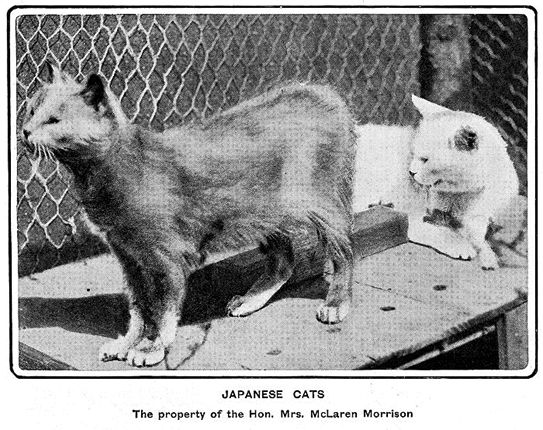
SHORTHAIRED CATS OF THE 19TH CENTURY - BLACK CHINESE, WHITE JAPANESE, BLACK SIAMESE, THIBET & SYRIAN
We have little but the National Cat Club registrations on these.The Cincinnati Enquirer, April 13, 1884 "Inauguration of the Feline Festival" lists one of the entries as "Our German Senator [owner], Japanese, New York City." The list of enries for the cat show in The Fitchburg Sentinel, November 9th, 1896 lists "Hotishiaa Zoom, Japanese," owned by Adrian L. Potter, manager.
According to "The Cat Show" reported in the North Adams Transcript, March 12, 1896: "Skip, a royal cat of Siam (sometimes called Japanese); zebra marked and colored, 9 mos., male, F. C. Witt, Greenfield." The same publication, on March 12, 1896 wrote: "The Japanese cat exhibited by Mrs. F. C. Witt of Greenfield is a rare beauty. Her fur is almost as short and sleek as that of a seal and she is striped in a way that reminds one of a zebra. This is the only Japanese cat on exhibition and she naturally attracts a good share of attention, both on account of her rarity and her beauty. This animal is valued at $100."
The "Any Other Variety Foreign Cat" class at the Crystal Palace in 1902 third go to an Indian cat and fourth to a Japanese cat. According to the journal "The Queen" in January 1900, "and there was a novelty in a Japanese cat, Miss Cochran's Pan, which took a first prize" at the Cat Club's Show at St. Stephen's Hall, adjoining the Aquarium, Westminster.
Mrs McLaren Morrison of Kepwick Park imported a pair of "Black Chinese" shorthairs and bred at least four offspring from them. The parents, Mandarin and Pekin, both won prizes in 1891 at Brighton and York. She also imported a pair of "White Japanese" (a term often used to mean Siamese conformation) and acquired a third Japanese cat (colour not given) from Mrs Mould, plus a grey male "Thibet" cat acquired from a French Missionary and a pair of Syrian cats. Mrs Mclaren Morrison was a great collector of curious varieties. She acquired the surviving Mexican Hairless Cat, Nellie, abd renamed her "Jesuit," but failed to breed her. She could have used backcrossing - a technique used by livestock farmers - to preserve the Mexican Hairless. She was heavily involved with importing and breeding dogs from different part of Asia.
The Tatler, 12th February, 1902, gives us this description of "The Cats of Japan" (also using the above photo) - "So far but few specimens of the breed have been exhibited in this country, though it is quite possible that here and there some unrecognised members of the family may exist which on account of similarity of shape may be confused with the Manx and exhibited as such, but to an expert the fur cannot be overlooked. The pair represented in the illustration belongs to Mrs. McLaren Morrison and was imported direct by the persons from whom they were bought; and their present owner, who has travelled a great deal in in Japan, recognises them as being genuine Japanese cats. Coats in Lavender and Orange. - The pure-bred ones have no tails and arc of all colours, but white are the most common ; the cat in the foreground is almost of a lavender shade with flecks of orange. It is now anything but an easy matter to obtain these cats as their value has become known, and high prices are asked; it therefore behoves those who may buy a cat at any of the seaports of Japan to see that they get a tailless and not a docked animal."

The Sketch, of June 10, 1896 tells us "It is at Kepwick Park that Mrs. Mclaren Morrison has her celebrated "catteries," [...] some Chinese cats with their long, wedge-shaped heads, bright golden eyes and shiny, short-haired black fur; and a pair of Japanese pussies, pure white, and absolutely without tails." This means the Chinese cats were early Black Oriental Shorthairs (Foreign Black) and the Japanese were a variety of Japanese Bobtail.

Meanwhile, Mrs Herring had a female Black Siamese whose name, Lady Curly Tail, evidently described her distinguishing feature. In later books she was referred to as Siamese, with no reference to her colour.
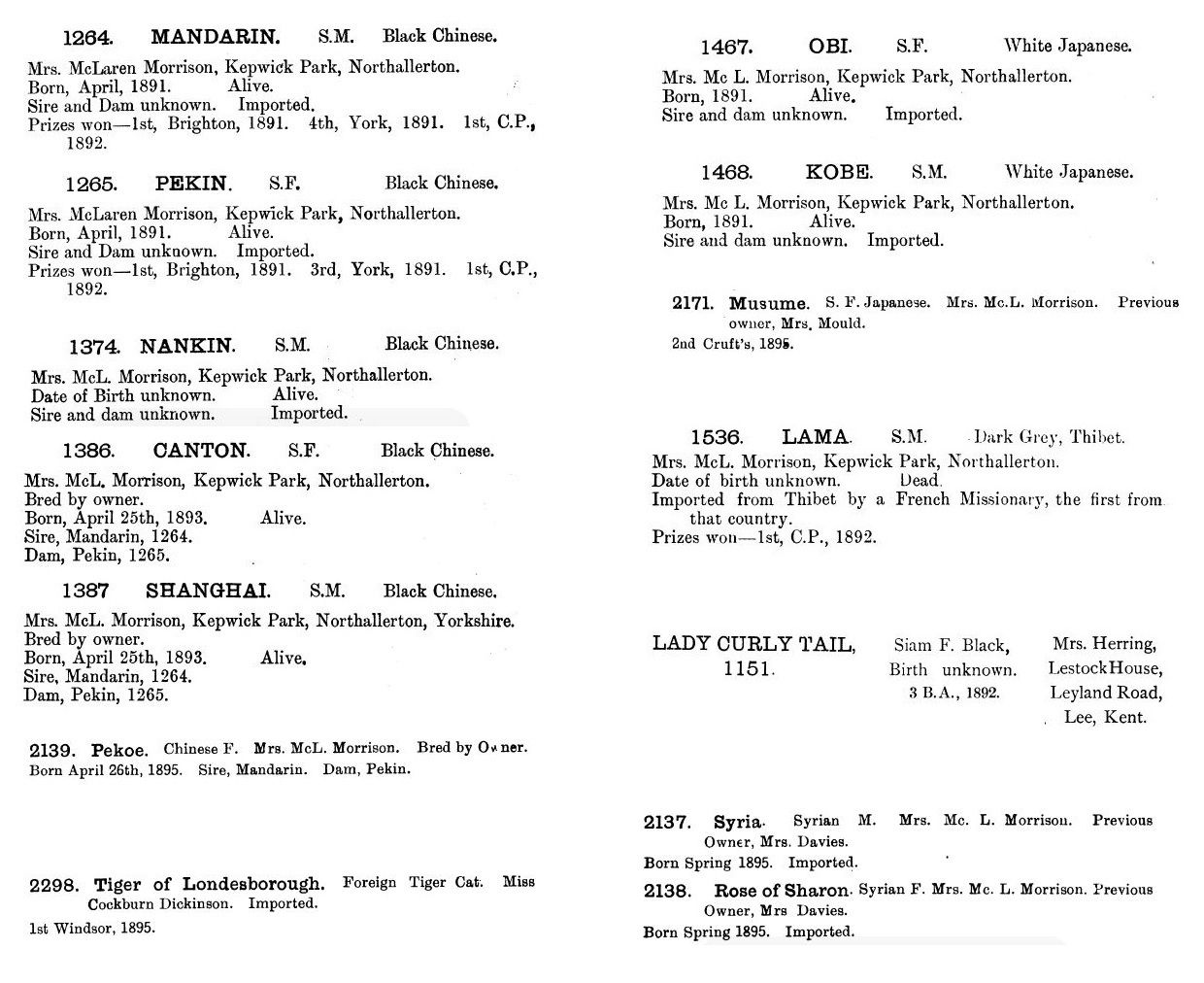

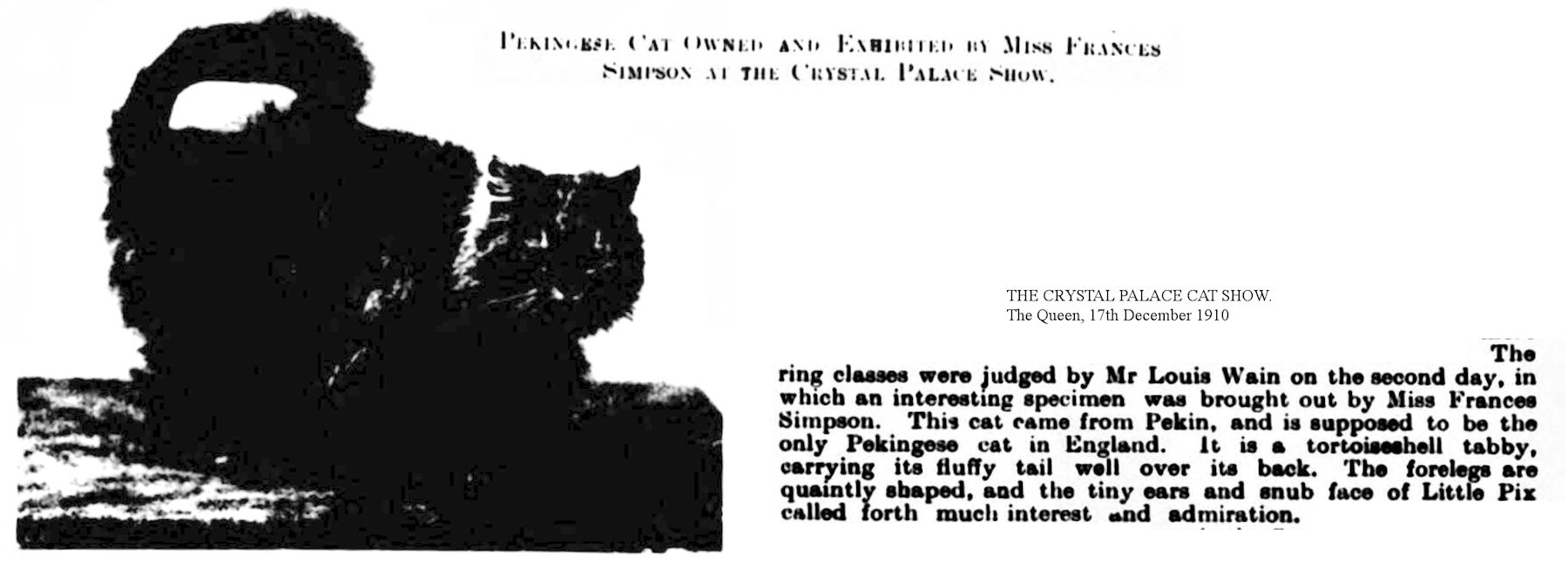
The "Thibet" cat imported by Mrs Mclaren Morrison appears to be the earliest account of a rex-coated (curly coated) cat. "A unique specimen from Thibet, said to be the first of the kind ever exhibited. This animal, which is the property of Mrs. D. M. Morrison, is black, with a covering which is more like wool than fur." (London Evening Standard, 19th October 1892). Among the curiosities at the Crystal Palace Cat Show is Lama," imported by Mrs D Morrison from Tibet, the first of the kind seen in this country. It is a rusty black with half-curled coat, not unlike that of an Airedale terrier." (South Wales Daily New, 20th October 1892). "The Thibetan cat, never before exhibited is a curious black animal with a woolly coat, as different from the long silky hair of the English cat as a negro s crop is from a modern belle s." (Exeter and Plymouth Gazette, 20th October 1892). "The cat from Thibet takes a first prize, due, perhaps, to its rarity, for such a specimen has never been previously exhibited. It is black, and its coat is more like wool than a cat's fur." (Nottinghamshire Guardian, 22nd October 1892). "A very curious beast, says the correspondent of a contemporary, came from Thibet. There is a distinct species of cat in that country which is not domesticated, but this Thibet cat was simply extraordinary variation of felis domestica. It was long-necked and lean creature, with a grey black coat, the peculiarity of which was that it was just the texture of Irish frieze. " (Preston Herald, 22nd October 1892). "The only distinctly new variety in the exhibition was a cat stated to have been imported from Tibet. This was a small, dark, slate-coloured specimen with frizzy or curly hair very much like the short hair of a negro." (Illustrated London News, 22nd October 1892)
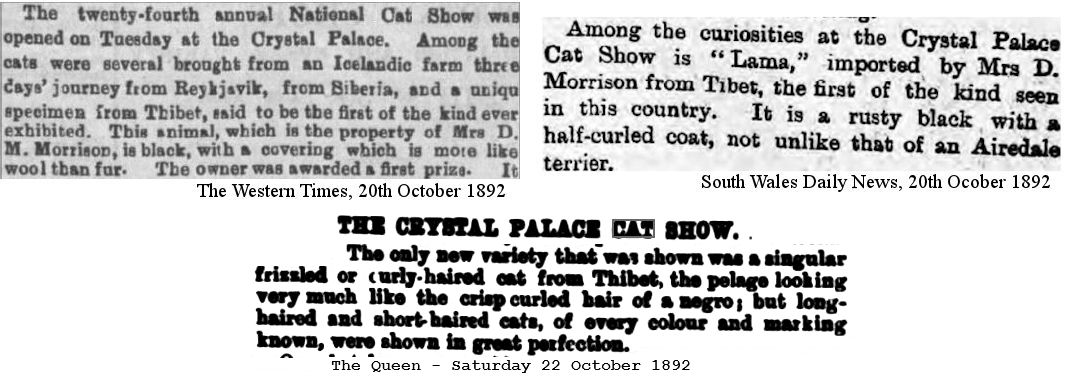
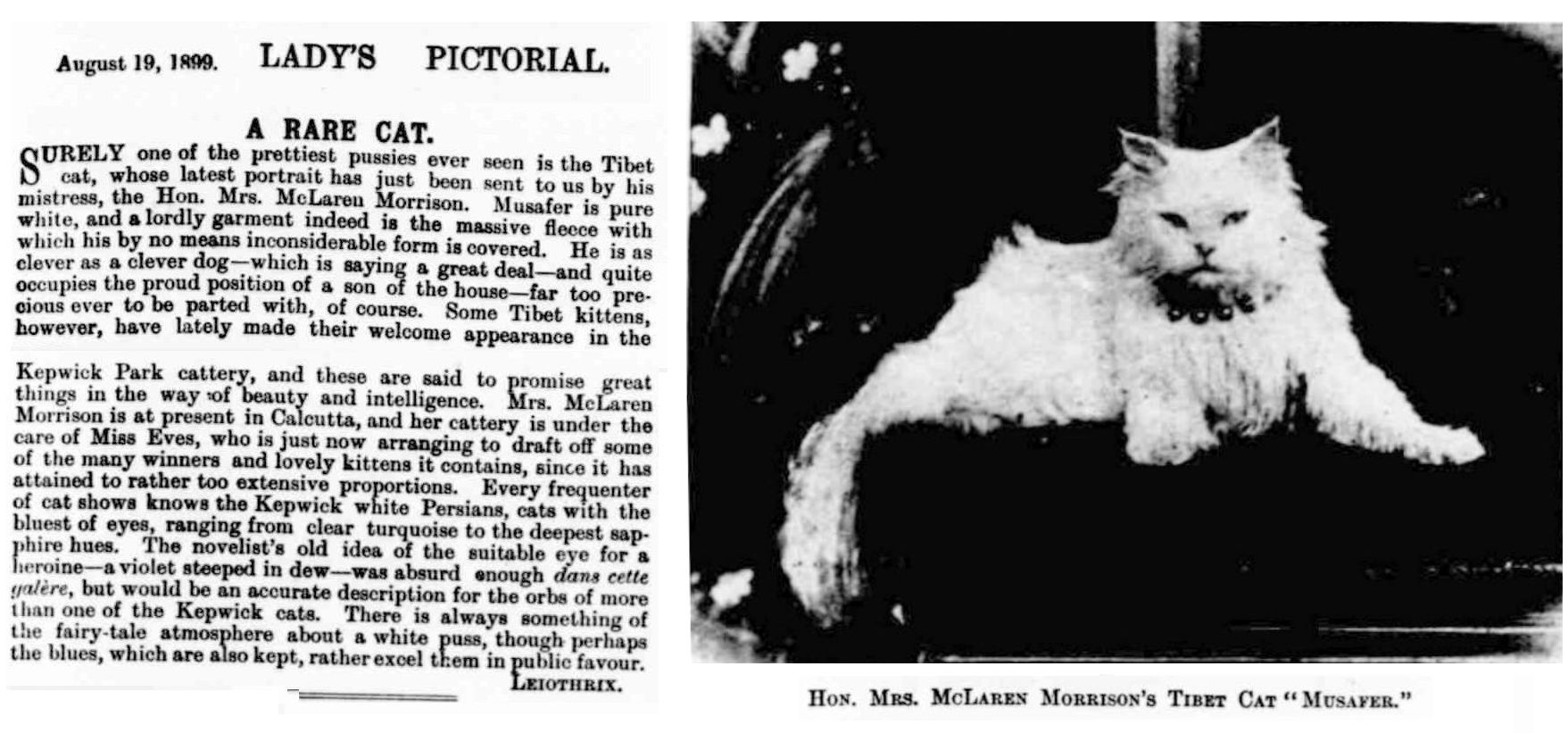
Meanwhile, Mr Woodiwiss had registered at least one Indian Fishing Cat (presumably Prionailurus viverrinus), though whether he intended to cross this with other cats is unknown. Their names may reflect their temperaments, although one won several prizes.

A number of unusual breeds are mentioned in early cat fancy literature. Some failed to attract sufficient interest from early cat fanciers. Others were based on hearsay and travellers tales and may never have existed in the form reported in early cat literature. Yet others were cases of mistaken identity (The Madagascar cat) or were mutations that were not perpetuated. Some of these "lost breeds" are known today by a different name although the early descriptions make it difficult to be certain. And yet other varieties, such as the British Tick/Bunny Cat, were absorbed into breeds that existed at the time. A few others were not cats at all.

One of the more amusing cases of mistaken identity was that of the "Madagascar Cat" which won the Foreign class at Crystal Palace (around 1900), but which turned out to be a Ringtailed Lemur. At the time, sailors sometimes brought back tame lemurs and called these little primates Madagascar Cats. The farce was reported in general newspapers as well as in the cat magazines of the time - surely a cat judge could tell the difference between a cat and a fruit-eating primate? Defending the decision, the judge (Miss H Cochran) reportedly stated "A lemur is a lemur, but a Madagascar cat is a Madagascar cat". A number of hybrids were also reported, including ones now known to be impossible such as the Civet/Cat hybrid and the Marten/Cat hybrid (the Civet referred to the Viverrine Civet, although the name has sometimes been used for the African Wildcat). There was also ongoing debate about the origins of the Siamese cats, with some enthusiasts insisting that it was descended from a cross between the Bay Cat and a viverrine. There were even early reports of Leopard Cat hybrids, decades before the Bengal was bred.
Although livestock breeders understood how to "fix" mutations by crossing to a more common type and then back-crossing the offspring to the mutant parent, cat fanciers seemed to hold out in the hope of finding a mate of the same type. The most famous loss was probably the original Mexican Hairless Cat, a breed that could have been saved. It would be some 60 years, and several missed opportunities, before the hairless type was re-established. Although we associate Peke-faced cats with the American Peke-faced Red Persian of the 1980s, a similar mutation was reported much earlier.
&nbs;